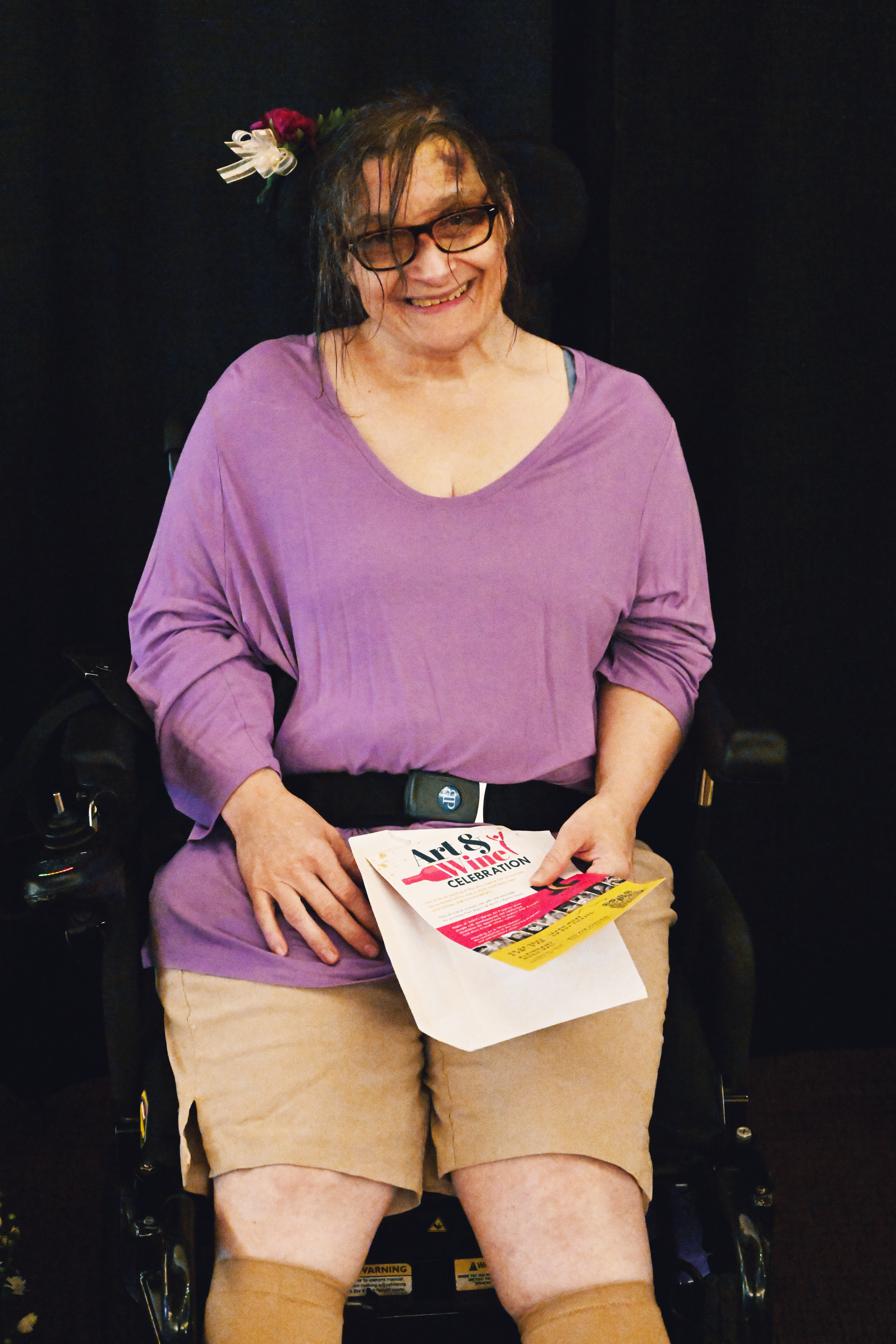
Two decades ago, an individual supported by Aspire of WNY, Mary Hunt, expressed her deep and personal connection to art in a poem that appeared in Aspire of WNY’s 2004 Literary Magazine. In her own words, she described how painting provided her with a sense of freedom as she navigated the challenges of living with a disability. During a time when her wheelchair made her feel trapped, the paintbrush became her escape.
Painting Sets Me Free
By Mary Hunt (2004)
I used to be able to walk.
Now I use a wheelchair.
It makes me feel
like I can’t do anything for myself.
I get depressed.
Sometimes I don’t want
to leave the house.
When I started painting,
it helped me express my anger.
Sometimes I am quiet
and painting helps me start talking.
It brightens up my day with colors.
Painting sets me free.
Flash forward to 2025, and her poem still holds true. Meet Mary. It’s Monday morning in the iXpress art studio at 7 Community Drive, and the flicker of fluorescent lights hums quietly. Against the walls, a row of easels stands, their wooden legs speckled with blotches of dried pants. At one of the tables, Mary Hunt leans forward, her arm stretching across the colorful battlefield of a well-loved workspace. She twirls her brush through a palette of sky-blue — the kind of blue that promises spring, because when words fail, Mary paints.
“A lot of my friends have machines that speak for them,” she says. “I use a paintbrush.” At first glance, Mary might strike you as shy; reserved and contemplative. But give her a canvas, and she’ll show you the whole spectrum of everything that makes Mary, Mary. Winding paths, blooming flowers, chattering streams, her paintings are bursting with motion and light, with hope and warmth. Her favorite subjects are spring and summer landscapes that evoke fresh air and new beginnings.
“I don’t like painting winter,” she says flatly. “Winter in Buffalo is inaccessible for people like me. I’ve been in a chair a long time, and snow and ice make it hard to get around. When it gets too cold, I can’t go outside at all. So why would I paint something that keeps me trapped?” Mary was 13 when she first picked up a paintbrush, and she’s held onto it ever since — a lifeline, a voice.
Each week in the iXpress studio, Mary creates something new. Something that might one day speak on her behalf. Her pieces have been featured in the agency’s Art & Wine Celebration 11 times. One year, her painting sold before she even arrived. “That felt good,” she says with a grin that carries both pride and surprise. “I want people to look at my paintings and feel something. I want them to think, wow — she really did something here.”
The act of painting is personal for Mary. Not just in what she paints, but in the right to create it her own way. She recalls a day when someone tried to change her palette mid-project. “I had to stop them and say, wait a minute — this is my painting,” she states. “I control the colors. Just because I have a disability doesn’t mean you get to make that choice for me. It wasn’t even about the colors. It was about it being mine.”
Mary has always known the importance of claiming space — in the art studio, in life, in the world. She’s currently in the process of navigating her way through a legal battle to obtain a new wheelchair part—a long and often frustrating journey that she hopes will empower others in her community to speak up, too. “My friends are scared to do it,” she says. “But I want to show them that it’s okay. You have to advocate for yourself and do what’s best for you.”
And when the world feels heavy— when systems are slow or sorrow sweeps in like a cold front — Mary turns to her art. Painting is her sanctuary, her meditation, her emotional archive. “When I’m upset, painting helps me calm down,” she says. “I think of something peaceful — a blue sky, flowers, a bridge — and I paint it. It always puts me in a better mood.” Each piece is carefully dated, like a diary entry in brushstrokes, a time capsule of emotion.
After the passing of her brother, that peace became harder to find. Her paintbrush sat untouched for a long time. But slowly, gently, she began to return. She keeps a picture of him on her bedroom wall—one that no one else is allowed to touch. Now, she has her sight set on one day painting it, as a tribute to him. “He still cares about me,” she says quietly. “I know he’s watching and waiting to see how far I’ll go.”
Mary has goals. Some small, some wide and wild. Finish her current pieces. Start painting more at home. Maybe even sell her work. But her biggest hope is to inspire others, especially people with disabilities, to take their next creative jump.
“I always tell people, just try,” she says. “Feel what you feel. Find your way to express it. It could be painting, or writing, or something else. If you don’t like it, that’s okay. But at least you tried. If I never picked up a paintbrush, I never would’ve known how good I could be. And I just keep getting better.”
Mary doesn’t paint for applause. She paints to exist loudly in a world that too often quiets voices like hers. She does not need approval, just space to do what she does best. And as long as she has a brush in her hand and an idea in her mind, she’ll just keep painting her way along.
